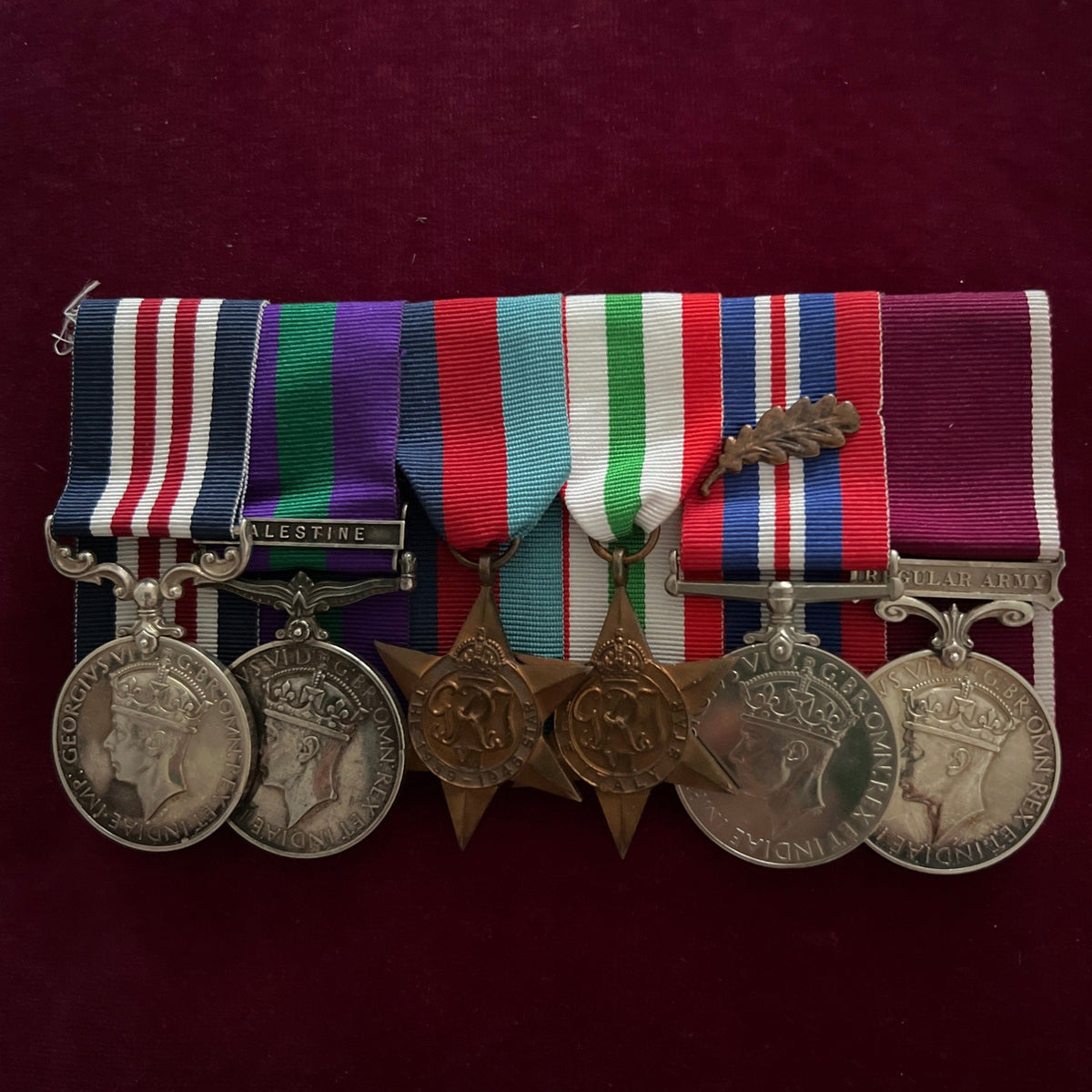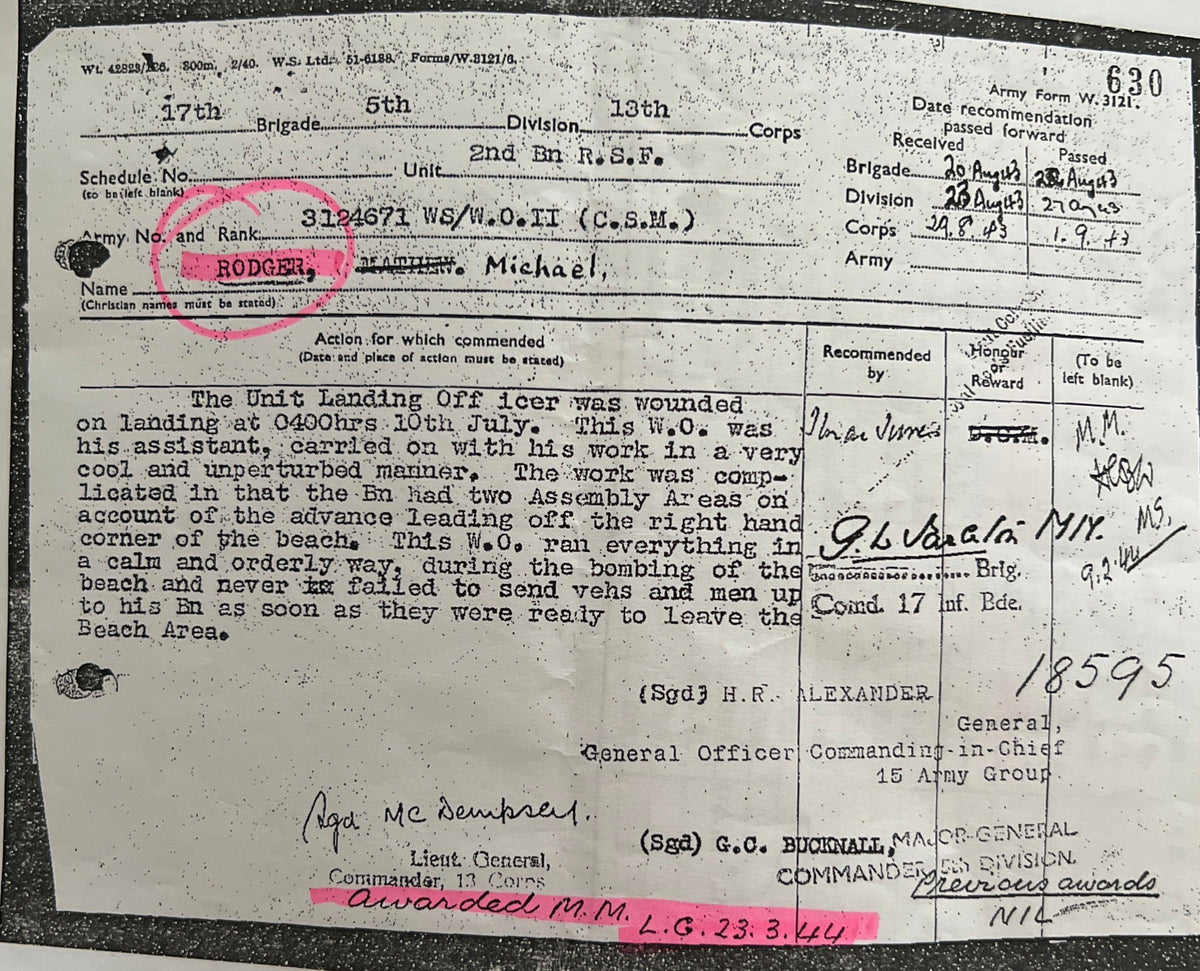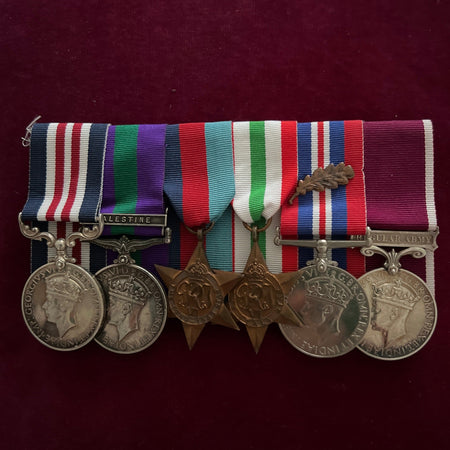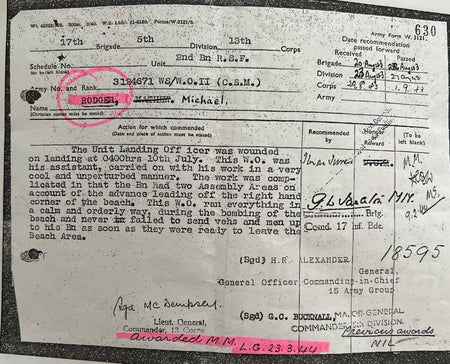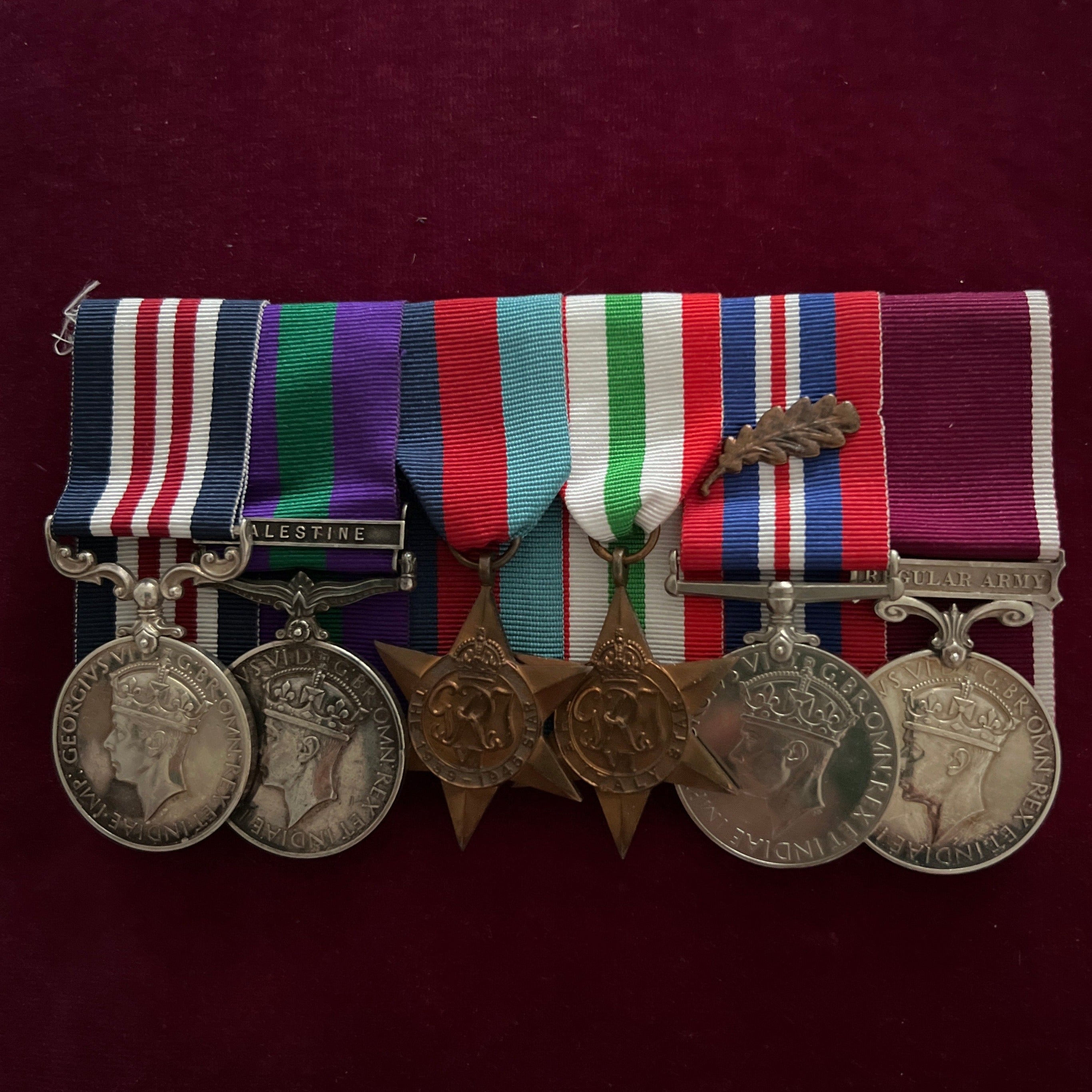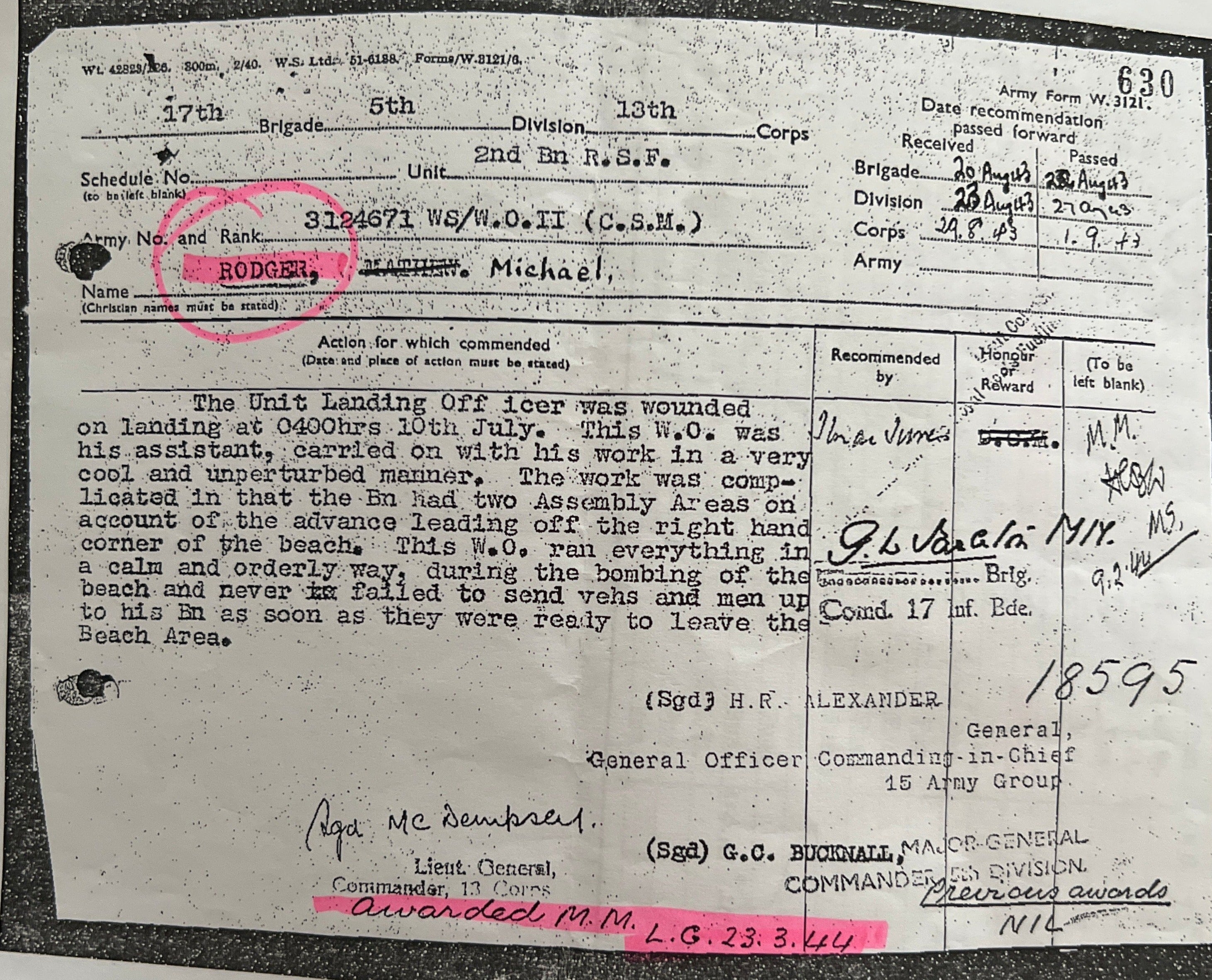WW2 Sicily Military Medal group to Regimental Sergeant-Major Micheal Rodger, 2nd Bn., Royal Scots Fusiliers. A pre-war regular he had served with 1st Bn., in Palestine 1932-36. See description
WW2 Sicily Military Medal group to Regimental Sergeant-Major Micheal Rodger, 2nd Battalion Royal Scots Fusiliers. A pre-war regular he had served with 1st Battalion in Palestine 1932-36.
Military Medal (G.VI.), impressed named 3124671 W.O. CL. 2. M. RODGER. R.S. FUS.: British General Service Medal (G.VI.), with clasp PALESTINE, impressed named 3124671 CPL. M. RODGER. R.S. FUS.: 1939 -45 Star, Italy Star, War Medal (1939-45) with M.I.D. device affixed, Army Long Service and Good Conduct Medal (G.VI.), impressed named 3124671 W.O. CL. 2. M. RODGER. R.S. FUS. Court mounted for display with copies of M.M. citation, medal roll, London Gazette extracts, and extracts from the History of R.S.F
M.M. Citation London Gazette 23/3/1944.
MiD, London Gazette 4/4/1946.
Citation reading: 'The Unit Landing Officer was wounded on landing at 0400rs 10th July. This W.O. was his assistant, carried on with his work in a very cool and unperturbed manner. The work was complicated in that the bn had two assembly areas on account of the advance leading off the right-hand corner of the beach. This W.O. ran everything in a calm and orderly way, during the bombing of the beach and never failed to send veh and men up to his Bn as soon as they were ready to leave the Beach Area.'
W.O. Class 2 Rodgers was a pre-war regular who probably enlisted in the late 1920's. He qualified for the GSM Palestine when serving with the 1st Battalion who served there from 1932 -36, his rank on the GSM is Cpl however the medal roll shows C.Q.M.S. (acting up?).
He was serving with the 2nd Battalion during the Sicily/Italian Campaign with the rank of Warrant Officer Class 2. Being awarded the Military Medal for his actions on 10/7/1943 during the landing at Sicily.
As the ships closed with the shore, a high wind rose as the moon went down and brought on a blustering night, and there was much sickness among the troops in the landing craft. Through a corridor of naval craft XXX Corps moved towards the Pachino Peninsula and XLII Corps in the general direction of Avola, an anxious and uncomfortable voyage of five miles.
The Scots Fusiliers lowered a first assault flight into the sea at 1.15 a.m. It consisted of 'A', 'B' and 'C' Companies and Battalion Headquarters, loaded into 1 2 landing craft. The swell delayed the forming up of the flotillas and the first wave did not land at its appointed place, a small bay opposite Cassibile, until 3.45 a.m. "A" Company was on the right, "B" in the centre and "C" on the left. "A" Company beached 300 yards to the south of their fixed position and some delay was caused in the northward march, in course of which they encountered and rushed a pillbox. The wireless sets, drenched in salt water, refused to function and Colonel MacInnes, still out at sea, had no information about events on the beaches nor of the situation of "D" Company which was still afloat in landing craft. Battalion Headquarters landed in three assault craft at 4.25 a.m. This was not well done, according to Colonel MacInnes, as the craft conveying his second-in-command, himself, and the beach naval party set them down on a rock in deep water and half an hour was lost before they could land. The headquarters staff refused to swim, as the precious wireless sets which remained to them would have shared the fate of the others. A Commando unit which should have landed to the north to soften up the beach defences did not arrive until the Fusiliers were completely disembarked; however the absence of resistance on the beaches made this unimportant. "D" Company appeared at 4.25; its landing craft had struck ground in three feet of disturbed water and the company had to wade ashore, accompanied by some attached troops, holding equipment and ammunition overhead to keep them dry. At some points on the beaches the Navy had used grappling irons to tear away the defensive hedges of barbed wire, but the Fusiliers relied upon Bangalore torpedoes brought for the purpose. A distant Italian field battery shelled the foreshore and the passage of a minefield proved difficult. The battery and the minefield both inflicted some casualties, including Major V. McNeil-Cooke, M.C., commanding Headquarter Company, who had been Adjutant of the Battalion after the return from Dunkirk in 1940, and five men of' B" Company. Its immediate difficulties overcome, the Battalion eventually moved off northwards from the assembly position towards Syracuse at 5.30 a.m. "B" Company was leading, followed by the reconnaissance and order groups, "C" Company, "D" Company, rear headquarters, regimental aid post and "A" Company less one platoon. Company Sergeant-Major Rodger and Sergeant Guthrie were left on duty at the assembly points.
He is mentioned in the History of the Royal Scots Fusiliers three times.
He was subsequently promoted to Regimental Serjeant Major of the battalion and awarded a M.I.D.

